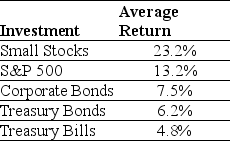Use the table for the question(s) below.
Consider the following average annual returns:
 -What is the excess return for the portfolio of small stocks?
-What is the excess return for the portfolio of small stocks?
A) 10.0%
B) 15.7%
C) 18.4%
D) 17.0%
F) A) and D)
Correct Answer

verified
Correct Answer
verified
The excess return if the difference between the average return on a security and the average return for
A) Treasury Bonds.
B) a portfolio of securities with similar risk.
C) a broad based market portfolio like the S&P 500 index.
D) Treasury Bills.
F) A) and B)
Correct Answer

verified
Correct Answer
verified